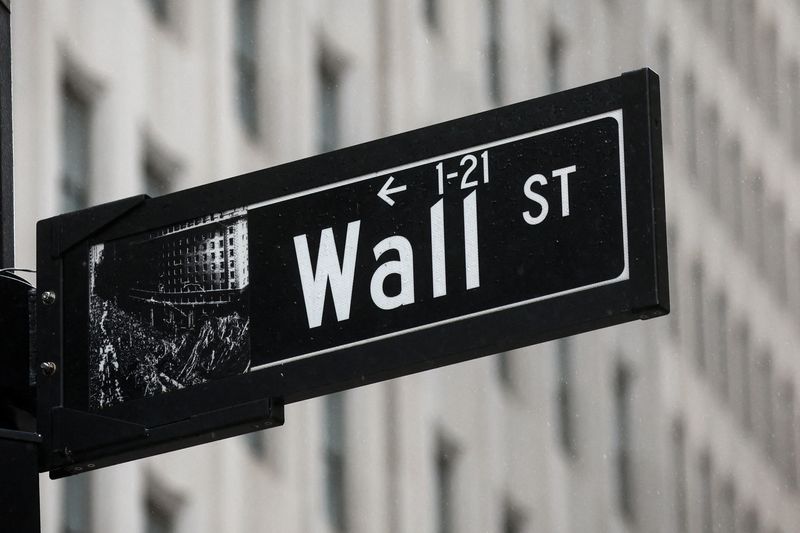By Stephen Culp
NEW YORK (Reuters) - U.S. stocks bounced back on Tuesday as largely on-target inflation data and easing jitters over contagion in the banking sector cooled expectations regarding the size of the rate hike at the Federal Reserve's policy meeting next week.
All three major U.S. stock indexes closed sharply higher, with the S&P 500 and the Dow gaining more than 1% and the tech-heavy Nasdaq surging more than 2%, after several sessions of risk-off turmoil driven by the fallout surrounding the implosion of Silicon Valley Bank and Signature Bank (NASDAQ:SBNY).
Financial stocks clawed back some losses, with the S&P 500 Banks index coming back from its steepest one-day sell-off since June 2020.
The KBW Regional Banking index rose 2.1%.
Bank contagion fears were allayed on Tuesday as U.S. President Joe Biden and other global policymakers vowed the crisis would be contained.
"The market is having an opportunity to digest some of the news over the last couple of days," said Matthew Keator, managing partner in the Keator Group, a wealth management firm in Lenox, Massachusetts. "(Investors) are seeing a coordinated effort with various government agencies, and with hindsight, they’re feeling as if things have contained themselves a bit."
The Labor Department's CPI report showed consumer prices cooled in February, largely in line with market expectations, with headline and core measures notching welcome annual declines.
Even so, inflation has a considerable way to go before approaching the central bank's average annual 2% target.
But signs of economic softness, combined with the regional banking scare, have increased the odds that the Federal Reserve will implement a modest, 25 basis-point hike to its key interest rate at the conclusion of its two-day policy meeting on March 22.
Financial markets have now priced in a 74.5% likelihood that the central bank will raise the Fed funds target rate by an additional 25 basis points at the conclusion of its two-day monetary meeting later this month, with a growing minority - 25.5% - seeing the potential of no rate hike at all, according to CME's FedWatch tool.
"Part of the stabilization today is folks feeling as if the Fed might back off from some of the hawkish expectations that followed Chairman Powell's comments last week," Keator added.
"If the Fed isn't careful, they could create some unintended shocks to the system," he said.
Shock waves following the closure of Silicon Valley Bank and Signature Bank, which prompted Biden to vow he would contain the crisis and ensure the safety of the U.S. banking system, continued to reverberate throughout the sector.
The S&P 500 banking index reclaimed territory, rising 2.6% after Monday's plunge, its biggest one-day drop since June 2020.
The Dow Jones Industrial Average rose 336.26 points, or 1.06%, to 32,155.4, the S&P 500 gained 64.8 points, or 1.68%, to 3,920.56 and the Nasdaq Composite added 239.31 points, or 2.14%, to 11,428.15.
All 11 major sectors in the S&P 500 ended the trading day higher, with communication services enjoying the largest percentage advance.
Shares of First Republic Bank (NYSE:FRC) and Western Alliance (NYSE:WAL) Bancorp surged by 27.0% and 14.4%, respectively, in a reversal of the previous session's rout.
Meta Platforms Inc (NASDAQ:META) announced 10,000 job cuts in its second round of layoffs. Its stock advanced 7.3%.
Ride-hailing app rivals Uber Technologies (NYSE:UBER) Inc and Lyft Inc (NASDAQ:LYFT) rose 5.0% and 0.6%, respectively, after a California state court revived a ballot measure allowing the companies to treat drivers as independent contractors rather than employees.
United Airlines Holdings (NASDAQ:UAL) Inc fell 5.4% after the commercial carrier unexpectedly forecast a current quarter loss.
AMC Entertainment (NYSE:AMC) Holdings slid 15.0% between multiple trading halts after its shareholders voted in favor of converting preferred stock into common shares.
Advancing issues outnumbered declining ones on the NYSE by a 2.60-to-1 ratio; on Nasdaq, a 1.83-to-1 ratio favored advancers.
The S&P 500 posted 3 new 52-week highs and 15 new lows; the Nasdaq Composite recorded 23 new highs and 195 new lows.
Volume on U.S. exchanges was 13.84 billion shares, compared with the 11.64 billion average over the last 20 trading days.
(This story has been refiled to fix garbling in paragraph 20)
